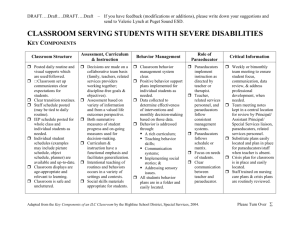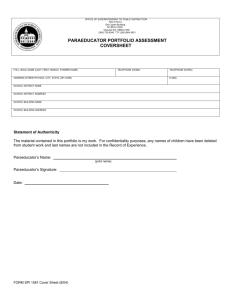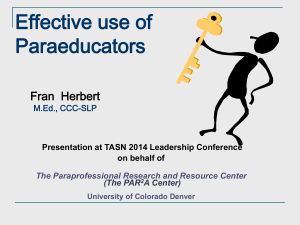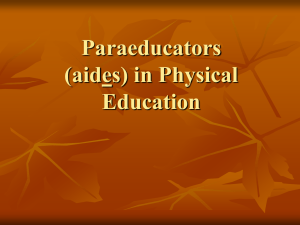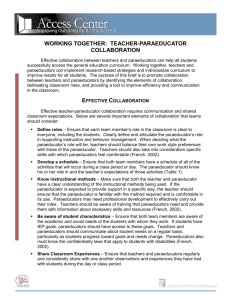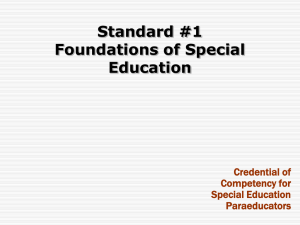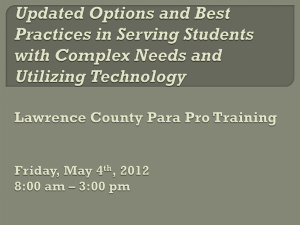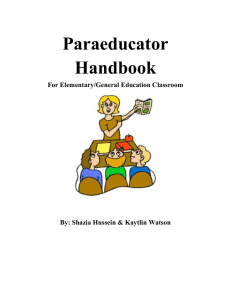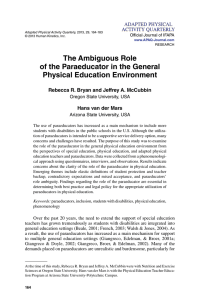Efective collaboration
advertisement
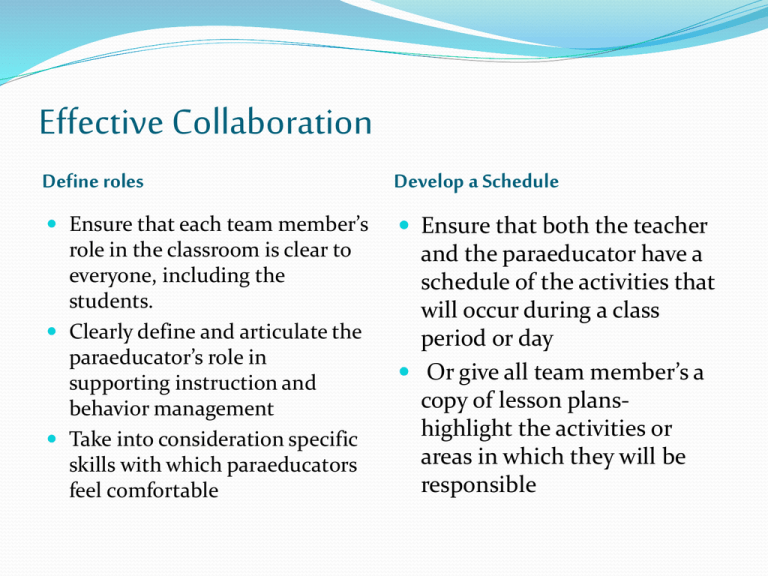
Effective Collaboration Define roles Develop a Schedule Ensure that each team member’s Ensure that both the teacher role in the classroom is clear to everyone, including the students. Clearly define and articulate the paraeducator’s role in supporting instruction and behavior management Take into consideration specific skills with which paraeducators feel comfortable and the paraeducator have a schedule of the activities that will occur during a class period or day Or give all team member’s a copy of lesson planshighlight the activities or areas in which they will be responsible Strategies Know Instructional methods Be Aware of Student Characteristics If the paraeducator is expected Both team members should to provide support in a specific way, the teacher should ensure that the paraeducator is familiar with the method required and is comfortable in its use Professional Development may be required to effectively carry out their roles Teacher’s should help to provide paraeducators with resources and necessary skills be aware of the academic and social needs of the students with whom they work Paraeducators should be aware of IEP’s Communication on a daily basis regarding student needs is important Confidentiality laws Strategies Share Classroom Experiences Share responsibility Open communication Ensure that each team Regularly and consistently member is working with all student’s equally No students should spend a majority of time with only the paraeducator share observations and experiences they have had with students during the day or period Additional Strategies Communicate that you are a team Be proactive regarding classroom and behavior management Be aware of how you communicate Discuss the issue of confidentiality Use a collaborative problem solving process References Devlin, P., (2008) Create Effective TeacherParaprofessional Teams. Intervention in School and Clinic 2008 44:41. www.isc.sagepub.com/content/44/1/41 http://www.k8accesscenter.org/training_resources/do cuments/Tchr-ParaCollaboration.pdf Roles and Responsibility Teacher Paraeducator Areas of Communication Plan all instruction, including small group activities Provide instruction in whole-class settings. Work with small groups of students on specific tasks, including review or reteaching of content Work with one student at a time to provide intensive instruction or remediation on a concept or skill Teachers provide specific content and guidance about curriculum, students, and instructional materials Paraeducators note student progress and give feedback to teachers Develop all lesson plans and instructional materials1 Ensure alignment with standards, student needs, and IEPs Provide assistance in development of classroom activities, retrieval of materials, and coordination of activities Mutual review of lesson plan components prior to class Teachers provide guidance about specific instructional methods Develop and guide class-wide management plans for behavior and classroom structures Develop and monitor individual behavior management plans Assist with the implementation of class-wide and individual behavior management plans Monitor hallways, study hall, & other activities outside normal class Teachers provide guidance about specific behavior management strategies & student characteristics Paraeducators note student progress & activities and give feedback to teachers Instruction Curriculum & Lesson Plan Development Classroom Management Classroom Management Accommodations & Modifications Develop and guide class-wide management plans for behavior and classroom structures Develop and monitor individual behavior management plans Assist with the implementation of class-wide and individual behavior management plans Monitor hallways, study hall, & other activities outside normal class Teachers provide guidance about specific behavior management strategies & student characteristics Paraeducators note student progress & activities and give feedback to teachers Determine (with IEP team) proper accommodations for students with disabilities Incorporate accommodations into all lesson plans Develop modified materials Guided by teacher and IEP, provide appropriate accommodations to material (enlarged print, taking notes, reading material aloud) Teachers guide paraeducators in the use of specific adaptations and ensure that paraeducators are aware of IEP goals and adaptations Paraeducators provide feedback about student progress and success of adaptations Current Issues Surrounding Paraeducators Privatization Paraprofessional Requirements under NCLB –Title I schools Paraprofessional Training Effective Collaboration in the Classroom Utilization of Paraprofessionals in Inclusive Schools Resources for Teachers and Paraeducators National Resource Center for Paraprofessionals. www.nrcpara.org/ If paraprofessionals are your training concern, or you ARE a paraprofessional, the NRC for Paras is for you. It publishes six different paraprofessional training manuals, including the Core Curriculum for Paraprofessionals. The goal of these instructional materials is to provide personnel developers and trainers with resources they can use to improve the performance of their paraeducator workforce. Here are some of the other resources you’ll find at the NRC, too. State Resources, which will connect you with state-developed regulations and resources for paras. The State of the Art Report, which provides an overview of how federal, state and local education agencies have addressed issues that influence the roles, preparation, and supervision of paraeducators. A Message Board for paraprofessionals. Books and manuals: Materials on and for paraeducators, all available at low-cost. Project EVOLVE. Project EVOLVE is an OSEP-funded project that’s generated a wealth of resources, including the paraprofessional literature from 1990-2009 and A Guide to Schoolwide Planning for Paraeducator Supports. http://www.uvm.edu/cdci/evolve/ Paraeducator Resource and Learning Center (PRLC). The PRLC provides information for paraeducators about six important topics: Collaborative Teamwork, Inclusive Education, Families and Cultural Sensitivity, Characteristics of Children and Youth with Various Disabilities, Roles and Responsibilities of Paraeducators and Other Team Members, and Implementing Teacher-planned Instruction. www.uvm.edu/~cdci/prlc/ Resources Continued CEC’s standards for paraprofessionals. CEC is the Council for Exceptional Children. Its Parability: The CEC Paraeducator Standards Workbook includes CEC Standards for Paraeducators, a Code of Ethics of Paraeducators, and two tools that can be used by district personnel, principals, trainers, and paraeducators to ensure that paraeducators meet the CEC Standards. The product number is #P5691 , cost is $10.95 ($12.95 for non-CEC members). To order, call toll-free 1-888-232-7733. | http://www.cec.sped.org/ScriptContent/Orders/ProductDetail.cfm?section=CEC_Store&pc=P5691 ParaEducator Learning Network This network helps school systems address paraeducator training needs via an e-learning program currently offering over 115 courses in a wide range of areas. A service center, district, or school starts the process by subscribing to the network services, purchasing individual “seats” for trainees ($75/seat). This gives the trainees access to the online training modules. Read all about it at the link below. http://www.paraeducator.net/ Project PARA. Project PARA conducts research and develops training materials for paraeducators and teachers who supervise them. The project provides web-based self-study programs that offer school districts resources to provide introductory training for paraeducators and/or the teachers who supervise them. These resources are offered free of charge to schools and teacher training programs. Participating schools provide an instructor or mentor who manages their own self study participants. http://para.unl.edu/index.lasso National Clearinghouse for Paraeducator Resources. The Clearinghouse offers a variety of resources including a focus on supporting paraeducators of culturally diverse backgrounds. http://www.usc.edu/dept/education/CMMR/Clearinghouse.html
